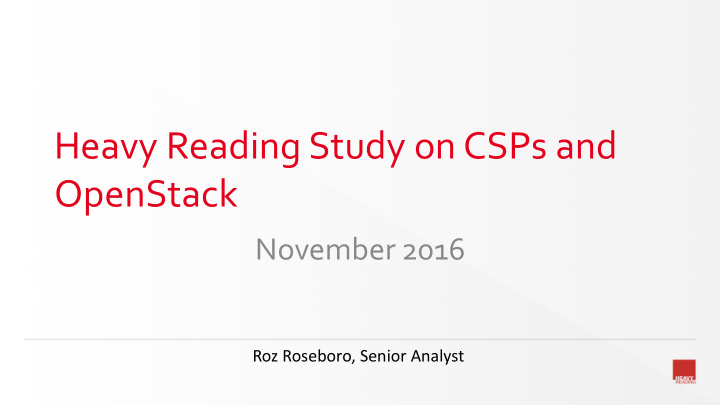



Heavy Reading Study on CSPs and OpenStack November 2016 Roz Roseboro, Senior Analyst
Operator type Fixed-line telecom network Mobile operator with operator network assets 17% 15% Other broadband service provider 5% Other CSP 3% Cable network operator 10% Converged operator (fixed and mobile network assets) Virtual network operator (no 46% network assets) 4% Source: Heavy Reading service provider survey, August 2016, n=113
Operator location Canada 9% Central/South America (including Mexico & the Caribbean) 9% U.S. Europe 54% 14% Middle East 3% Asia/Pacific (including Australia) 11% Source: Heavy Reading service provider survey, August 2016, n=113
Operator size $1 billion to $5 billion 18% $500 million to $1 billion 7% $100 million to $500 million 12% More than $5 billion 46% $50 million to $100 million 5% Less than $50 million 12% Source: Heavy Reading service provider survey, August 2016, n=113
Respondent roles R&D technical strategy 23% Network planning 12% Corporate management 8% IT operations 12% Other 3% Software developer 1% Customer support 2% Sales & marketing 4% Product/Service management Network engineering 12% 23% Source: Heavy Reading service provider survey, August 2016, n=113
Familiarity with OpenStack Very familiar 27% Somewhat familiar 73% Source: Heavy Reading service provider survey, August 2016, n=113
NFV strategy execution status We are already executing our NFV strategy 40% We have an NFV strategy but we haven’t started executing it yet 18% We have no plans to adopt NFV 2% We are now developing our NFV strategy We are just starting to 26% consider an NFV strategy 14% Source: Heavy Reading service provider survey, August 2016, n=113
Cloud strategy execution status Enterprise cloud applications 55% 26% 13% 6% Hosting business 50% 23% 15% 12% Already using Testing NFV 26% 42% 30% 2% Considering No plan to use IoT 25% 27% 41% 7% 5G 5% 38% 39% 18% 0% 20% 40% 60% 80% 100% Source: Heavy Reading service provider survey, August 2016, n=109-111
Experience with open source software A lot 31% None at all 2% Some 67% Source: Heavy Reading service provider survey, August 2016, n=113
Level of engagement with OpenStack It is actively involved and contributes indirectly to OpenStack (e.g., via It actively follows OPNFV) OpenStack, but is not 20% contributing yet 37% It is actively involved and contributes directly to OpenStack 17% It is not engaged with OpenStack and has no It is not yet engaged with plans to get involved OpenStack but would like to be 4% 22% Source: Heavy Reading service provider survey, August 2016, n=113
Nature of engagement with OpenStack Contribute requirements and use cases Attend events Follow openstack.org, superuser.openstack.org, and other Internet… Contribute to the software On mailing lists (e.g., operator, user committee, Foundation, community,… Participate in IRC meetings 0% 20% 40% 60% 80% 100% Source: Heavy Reading service provider survey, August 2016, n=41
OpenStack project contributions Neutron Nova Tacker Telemetry/Ceilometer Other 0% 10% 20% 30% 40% 50% 60% 70% 80% Source: Heavy Reading service provider survey, August 2016, n=26
OpenStack event participation OpenStack Summit OpenStack Days Local meetups Other 0% 10% 20% 30% 40% 50% 60% 70% 80% Source: Heavy Reading service provider survey, August 2016, n=30
How to increase engagement More mature underlying technology More telecom operator support of the project More vendor support of the project More/better documentation specific to telecoms More targeted telecom- specific use cases/activities Dedicated meetups for telecom operators Dedicated mailing lists to for telecoms Other 0% 10% 20% 30% 40% 50% 60% 70% Source: Heavy Reading service provider survey, August 2016, n=107
Importance of OpenStack Marginal 13% Important, but not essential 58% Not important at all 1% Essential 28% Source: Heavy Reading service provider survey, August 2016, n=113
OpenStack usage by service type To manage our internal cloud 32% 32% 26% As the basis for NFV 22% 39% 38% Already using To manage our customer- Testing 19% 30% 36% facing public cloud Considering No plan to use As the basis for IoT 12% 29% 50% As the basis for 5G 3% 28% 49% 0% 20% 40% 60% 80% 100% Source: Heavy Reading service provider survey, August 2016, n=108-111
OpenStack benefits by service type To manage To manage our As the basis As the As the Other our internal customer- for NFV basis for basis for cloud facing public IoT 5G cloud Respond to 39% 37% 39% 41% 36% 4% changing service demand Offer new services 53% 62% 54% 52% 48% 3% more quickly More rapid 44% 34% 50% 41% 35% 2% virtualization of the data center Reduced software 43% 39% 49% 31% 29% 2% costs Reduced 43% 42% 43% 34% 41% 2% Source: Heavy Reading service provider survey, August 2016, n=92-104 operational costs
OpenStack procurement We will get OpenStack as part of the OPNFV reference We will use a vendor- architecture supported distribution of 21% OpenStack 65% We will download a freely available version of OpenStack 14% Source: Heavy Reading service provider survey, August 2016, n=108
Making OpenStack NFV-ready Item Score* Overall Rank Scalability of the controller(s) 103 1 Service chain modification 74 2 Securing OpenStack over the Internet 61 3 Backward compatibility between releases 35 4 Binding virtual NICs to VNFs 28 5 Start-up storms (or stampedes) 10 6 * Score is a weighted calculation. Items ranked first are valued higher than the following ranks, the score is the sum of all weighted rank counts.
Container usage by service type For VNFs 29% 40% 31% Will definitely use containers Will probably use containers May or may not use containers For business applications 22% 42% 36% Will definitely not use containers Other 0% 20% 40% 60% 80% 100% Source: Heavy Reading service provider survey, August 2016, n=110-111
Questions?
Recommend
More recommend